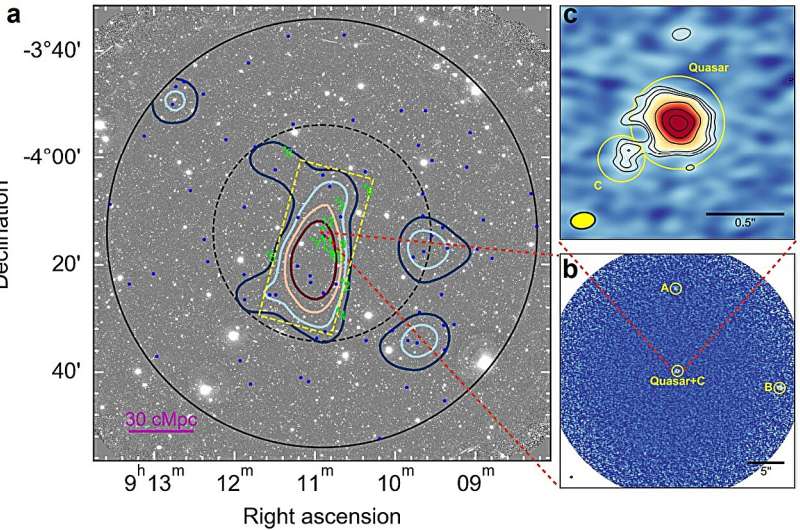February 13, 2024 report
This article has been reviewed according to Science X's editorial process and policies. Editors have highlighted the following attributes while ensuring the content's credibility:
fact-checked
preprint
trusted source
proofread
Astronomers discover massive protocluster around luminous quasar

Astronomers from the Steward Observatory in Tucson, Arizona and elsewhere report the detection of a new massive protocluster. The structure was found around a luminous quasar known as J0910–0414. The discovery was detailed in a paper published February 2 on the pre-print server arXiv.
Galaxy clusters harbor from hundreds to thousands of galaxies bound together by gravity. They are the most immense gravitationally bound structures in the universe, and could serve as excellent laboratories for studying galaxy evolution and cosmology.
Astronomers are especially interested in studies of protoclusters of galaxies, the progenitors of clusters. Such objects, found at high redshifts (over 2.0), could provide essential information about the early phases of the universe.
Recently, a team of astronomers led by Steward Observatory's Feige Wang has employed the Hyper Suprime-Cam (HSC) on the Subaru Telescope, the Atacama Large Millimeter/submillimeter Array (ALMA) and other ground-based facilities, to observe J0910–0414—a luminous quasar at a redshift of 6.63. The quasar hosts one of the most massive (about 3.6 billion solar masses) supermassive black holes at such a high redshift. Due to this, it is a good place to search for galaxy overdensities and therefore new galaxy clusters as well as the earliest protoclusters.
"The Subaru/HSC observations were obtained from November 2019 to January 2020. We observed this quasar field with i2, z and NB926 filters and the on-source exposure times are 150 minutes, 240 minutes, and 313 minutes, respectively," the researchers wrote in the paper.
The observations found a protocluster anchored by J0910–0414, which includes at least three carbon [C II] line and 12 Lyhman-alpha emitters (LAEs) at the quasar's redshift. The images also show a double-peaked LAE in the vicinity of the quasar.
According to the study, the newfound protocluster is one of the most overdense structures known in the early universe. Moreover, the present-day mass of this structure is estimated to be some 6.9 quadrillion solar masses—therefore three times greater than the nearby Coma cluster. This means that the protocluster reported in the paper is the most massive one found at a redshift higher than 6.0.
Summing up the results, Wang's team underlined that it is efficient to identify galaxy overdensities by targeting quasar fields with both ALMA and narrow-band observations, which was proved by the discovery of a new protocluster.
"Future ALMA mosaic observations, wide-field narrow band imaging, and JWST [James Webb Space Telescope] observations of quasars in the EoR [Epoch of Reionization] will allow us to not only identify galaxy overdensities in the EoR but also study the environmental dependence of galaxy evolution," the scientists conclude.
More information: Feige Wang et al, A Massive Protocluster Anchored by a Luminous Quasar at z=6.63, arXiv (2024). DOI: 10.48550/arxiv.2402.01844
Journal information: arXiv
© 2024 Science X Network





















